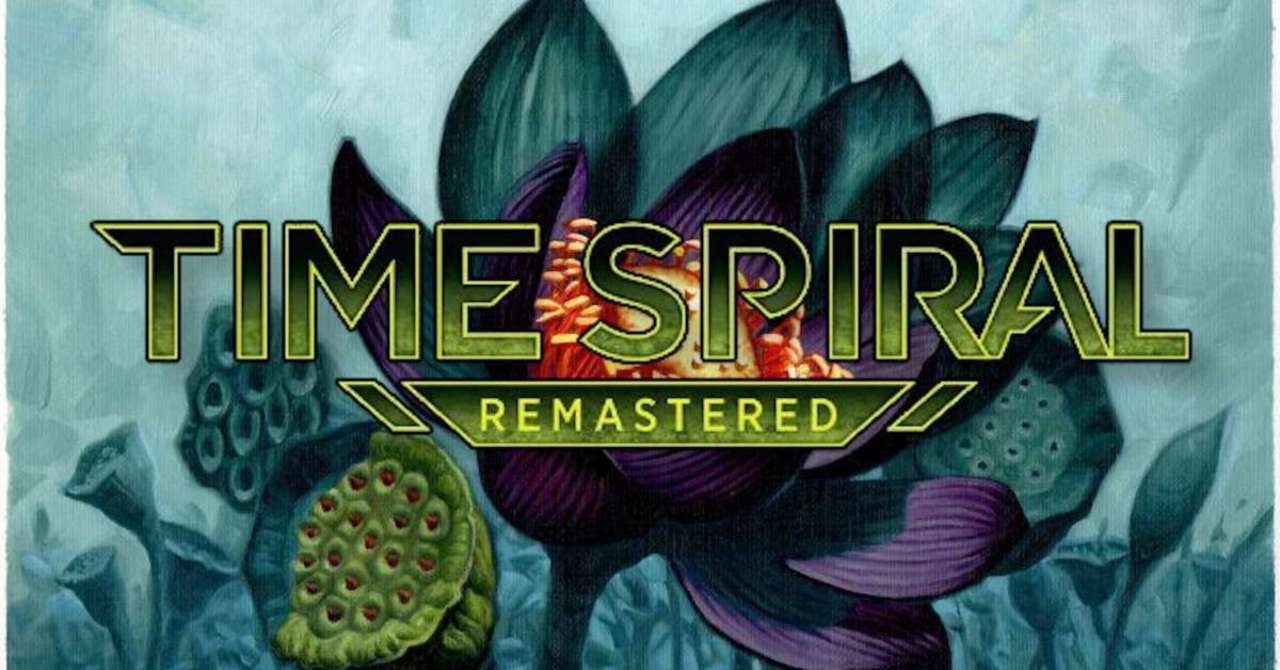Time Spiral: Remastered is a reprint set like Modern Masters or Double Masters before it. The theme of this set borrows from the MTGO-only set Tempest Remastered and the Arena-only sets Kaladesh and Amonkhet Remastered but with the added twist of bringing the remastering to print formats. The biggest twist of Time Spiral: Remastered is its timeshifted subset of cards. Similar to the original Time Spiral, the set features a series of cards printed in the past and “timeshifted” foward, though this new set features cards that were first printed in the Mirrodin expansion in 2003 or later instead of reprints of the original timeshifted subset, and these cards have been printed in the original card frame (pre-8th edition). Time Spiral: Remastered will be available on MTGO and for tabletop on 19 March 2021. Cards printed in Time Spiral: Remastered will not be legal for play in the Standard format unless a card happens to be in a Standard-legal set already (and there are eight of them as of this writing). Time Spiral: Remastered will also not be legal for the Pioneer format as a whole, but seventy cards in the set are reprints of cards in Pioneer-legal sets.
Like the Remastered sets before it, Time Spiral: Remastered is a reprint set with a list of cards selected from the three sets of the original Time Spiral block sets released in 2006 and 2007: Time Spiral, Planar Chaos, and Future Sight. The Time Spiral block occupies a peculiar place in Magic’s history. It was the first block set on the plane of Dominaria since the release of Scourge in 2003. The three blocks before it (Mirrodin, Kamigawa, Ravnica) were set on other planes of the multiverse and had little to do with Dominaria, though some characters from Magic’s history had some connection to them. The story of Time Spiral block was focused on characters from Magic’s backstory who survived the Phyrexian Invasion and their efforts to undo the effects of the shenanigans of their own doing or of their predecessors such as Urza and Nicol Bolas. In the end, they undid all of the time anomalies and changed the nature of the planeswalker spark, paving the way for Wizards to finally introduce the planeswalker card type in 2007’s Lorwyn expansion and their powers in the story.
The block itself is very complicated, both mechanically and in its flavor. The block’s theme is about time—the past, present, and future: Time Spiral is themed on the past, Planar Chaos is themed around an alternative present reality, and Future Sight is themed on possible futures. The block featured new mechanics such as suspend and split second and reused nearly every mechanic in the game’s then thirteen-year history. Time Spiral featured a subset of 121 cards that were reprints of cards from 1993’s Limited Edition to 2003’s Scourge. These cards used the original card frame, their original illustrations, and had updated rules text. Every pack of Time Spiral contained one timeshifted card with their own purple rarity symbol. Cards in the regular set were heavy on callbacks from the game’s early history. Planar Chaos’s theme of an alternate reality had cards that had their own frame and were “colorshifted” versions of cards. These cards functioned exactly the same as their original versions, though sometimes with adjustments to make them fit the overall spirit of the card. Future Sight’s theme of possible futures contained cards with their own unique frame and were cards that could one day see a reprint in a Standard-legal set or a forecast of a possible mechanic, even if the cards needed to make it work didn’t exist yet.
Standouts
There’s nothing in the way of new cards in Time Spiral Remastered, but there are some things worth looking at in the set, whether you were around for it the first time or are coming into things fresh.
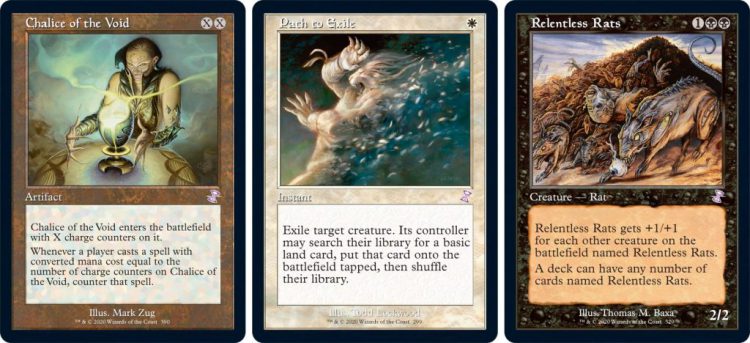
Timeshifted Standouts
This is certainly the biggest treat for Magic players who have been playing since the nineties and early aughts. All 121 cards in the timeshifted subset are reprints from cards introduced in Mirrodin or later in the original card frame. This subset is like a miniature Modern Masters set. All but nine cards are legal for the Modern format, and sixty of them are legal for Pioneer. Wizards selected the timeshifted cards with constructed play and for Commander in mind. Everything in the subset is played in at least one format, so everything’s going to find a home in a deck somewhere. I’ll only be pointing out the cards that are the biggest bangers in their color or something interesting about them. Some cards do seem like an excuse to print them in the old frame, the worst that any of these cards will do for you is not fit into your draft or sealed deck. Nothing in this subset is a total dud like Consecrate Land, Squire, or Dragon Whelp were. Even if you pull a timeshifted card that you are not happy with, someone else will be more than happy to trade you for it or buy it off you, especially if it’s foil.
White
- Containment Priest – This was reprinted in Core Set 2021, putting it in the small list of cards in Time Spiral: Remastered that are Standard-legal.
- Lingering Souls – Cards with flashback in Odyssey block were printed with a gravestone just left of the card title to serve as a reminder for their ability. New cards with flashback didn’t have it, but the timeshifted edition includes the gravestone as a callback.
- Path to Exile – Still one of the best point removal spells in Modern for one mana.
Blue
- Master of the Pearl Trident – A callback to the inclusion of Lord of Atlantis in the original timeshifted set.
- True-Name Nemesis – This will probably win you every game of limited you can resolve it in and will make you want to jump off a cliff if you’re on the wrong side of one. It’s the best creature in Legacy and Vintage at doing nothing but being able to attack and block.
Black
- Dismember – Another powerful removal spell in Modern and Legacy that any deck can play thanks to its Phyrexian mana symbols in its casting cost. This spell can be cast for two life for each Phyrexian mana symbol instead of black mana. The cost of four life will add up quickly if this is your only removal spell in your deck, so make it count.
- Stinkweed Imp – The gravestone symbol used on Odyssey block cards with flashback, despite not using the mechanic itself. Stinkweed Imp is the only card with dredge that can dredge for five, making it a staple in dredge decks.
- Thoughtseize – The most valuable card in the set, and it’s an absolute house in the formats it’s legal in for being able to pick off any nonland card from your opponent’s hand for one mana.
Red
- Dreadhorde Arcanist – One of the casualties of the February banned and restricted announcement, Dreadhorde Arcanist was banned from Legacy before the release of this set, but this is the risk Wizards takes with cards in reprint sets like this. It’s still very powerful in Modern and Pioneer with a critical mass of one-mana spells in your graveyard.
- Lava Spike – A staple in Modern and Legacy burn decks where you want to get the highest amount of damage you can with the least amount of mana to pay for it.
Green
- Primeval Titan – Its ability to find any two lands in your library when it enters the battlefield or attacks makes it the keystone to decks in Modern that win with a combo centered on land cards and is a solid beater in its own right.
- Ancient Stirrings – In Urzaron decks, Ancient Stirrings can select nearly any card that it reveals. It’s a powerful card selection tool in colorless decks and at its worst will find your missing Tron land or give you the Ulamaog, the Ceaseless Hunger, Karn Liberated, or Ugin, the Spirit Dragon you were looking for to close out the game.
Multicolor
- Abrupt Decay – A removal spell that will deal with nearly any card in its range of targets without worry of your opponent holding a counterspell and is typically the best answer for Counterbalance and Chalice of the Void.
- Bloodbraid Elf – The centerpiece of Jund decks during its time in Standard and was for three years banned in Modern when the deck seemed unstoppable in 2013 (it turned out that the real culprit was Deathrite Shaman). A Bloodbraid Elf will be able to cast your suspend spells with its cascade ability—even if it’s a card like Restore Balance or Ancestral Vision that has no mana cost.
- Knight of the Reliquary – A powerful midrange card that can utilize your spent fetchlands to boost its power and toughness, as well as being able to add to the number of lands in your graveyard to search for lands with abilities for a specific situation or to combo with Retreat to Coralhelm.
Artifact
- Chalice of the Void – This artifact will cut off your opponents from all of their one-mana spells (and your own), making it a key piece of prison decks or as a tool to fight off combo decks and other decks that rely heavily on one-mana spells.
- Solemn Simulacrum – Also in Standard for until rotation in autumn, but is also a callback to the other cards from the original timeshifted subset that featured Magic invitational winners who designed their own cards and had their likenesses used in them.
Lands
- Mystic Sanctuary – Another casualty of the recent bans in Modern for being a part of a combo with Cryptic Command to recur Cryptic Command from the graveyard and tap out all of your opponent’s creatures until you could beat them down.
- Field of Ruin – This has overtaken Ghost Quarter in Modern as the means to deal with problematic nonbasic lands. If you’re able to recur Field of Ruin, you can erase nearly all of your opponent’s lands if they’re leaning heavily on nonbasic lands. This card is also legal in Standard until rotation, but also a likely card for reprint in a future Standard format.
Main Set Standouts

White
- Angel’s Grace – Paired with Ad Nauseam to prevent losing by life loss by putting your entire deck into your hand, then casting your game-ending spell. That spell is either Lightning Storm with enough lands in hand to kill your opponent several times over or to cast a Thassa’s Oracle with no cards left in your library.
- Aven Mindcensor – A trick card used against fetchlands and tutor cards to counter them. An Aven Mindcensor can cost an opponent their fetchland and give them no legal cards to find in their top four cards of their library or stop them from finding their silver bullet card.
- Mana Tithe – The colorshifted version of Force Spike. You will probably catch someone completely off guard by casting it out of a taxes deck.
- Restore Balance – Part of a cycle of cards that have no mana cost of their own and can only be cast with their suspend ability. Decks are built around cheating these cards into play with abilities like cascade or with As Foretold. A well-timed Restore Balance can erase your opponent’s manabase, board, or hand.
- Serra Avenger – An efficiently costed flying beater. Its drawback can be gotten around by using a turn-one Aether Vial with two charge counters on it to put it on the battlefield on turn three or an accelerated Collected Company. Even if you are paying the full retail value to cast it, you’ll be ahead on mana for the amount of power in the air it has.
- Sinew Sliver – The colorshifted version of Muscle Sliver. Multiples of them with Predatory Sliver in Modern or Muscle Sliver in Legacy or Pauper will stack up the power of your other slivers on board and close the game.
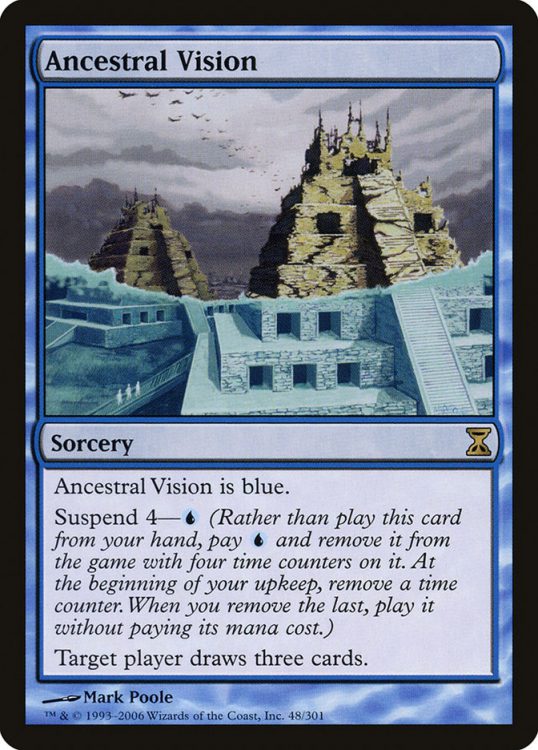
Blue
- Ancestral Vision – Refills your hand on turn five if you can suspend it on turn one in a control deck. In a deck that’s light on one-mana spells to cast on your first turn, you’ll likely be ahead on cards in hand by the time Ancestral Vision comes off of suspension when your opponent might be down to two or three cards. It gets much weaker the later you suspend it, but if you have ways to cheat it out and get the effect immediately, it will still be very powerful.
- Pact of Negation – Used as a hail mary and only ever cast with the intention of winning the game in the same turn. A deck like Amulet Titan will usually have the mana necessary to pay the fee when it’s due, but the steep delayed trigger will make you commit to your alpha strike. Remember that casting more than one Pact of Negation will mean that you must pay for each delayed trigger.
- Venser, Shaper Savant – Both a counterspell and a bounce spell for whatever your situation calls for. It leaves behind a body that can repeat the effect with flicker abilities (Venser’s specialty). Venser’s ability to return a spell to its owners hand is a way to defeat spells that can’t be countered, even if it only delays them from resolving for another turn.
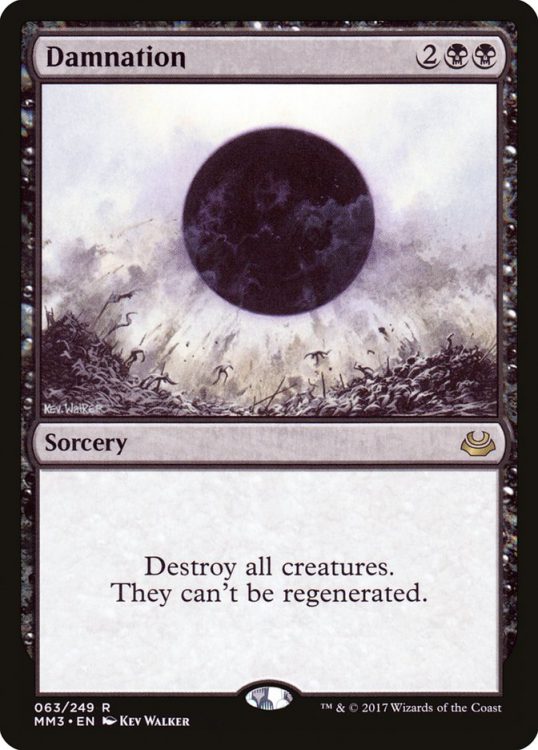
Black
- Damnation – The colorshifted version of Wrath of God. This will be the second booster pack reprint of Damnation since Modern Masters 2017 Edition. Getting kicked up to mythic rarity stings, but it’s the strongest sweeper in black. Try to pick up at least two of them if you’ve ever been curious about playing Modern.
- Extirpate – Extirpate picks out a card from your opponent’s graveyard and any copies of it from their hand and library and exiles them. This effect is useful for erasing cards that need to be in a player’s graveyard before they are reanimated or whatever other shenanigans your opponent is up to. Just remember to cast it in response to a reanimation spell or ability that’s on the stack before it resolves, or else you’ll be too late because Extirpate has to have a legal target in a graveyard. Extirpate is not useful for getting rid of a card that just annoys you or is not necessary for your opponent to win the game with. It’s a silver bullet to be used against certain decks, not anything. Extirpate has not seen much play in Modern because Surgical Extraction can be cast for no mana. Since the release of Modern Horizons in 2019, Force of Negation has made it a little harder to punish an opponent with Surgical Extraction, but Extirpate’s low mana cost and split second make it a little more appealing, if only as a fifth copy of Surgical Extraction.
- Living End – The title card of a combo deck that plays creatures with high power and cheap cycling costs to load its graveyard, cast a three-mana spell with cascade, and cast Living End to reanimate its cycled creatures and delete its opponent’s board.
- Slaughter Pact – The black member of the cycle of pacts from Future Sight. Its delayed trigger isn’t hard to pay for and it can buy you a turn by waxing a creature after you’ve tapped out.
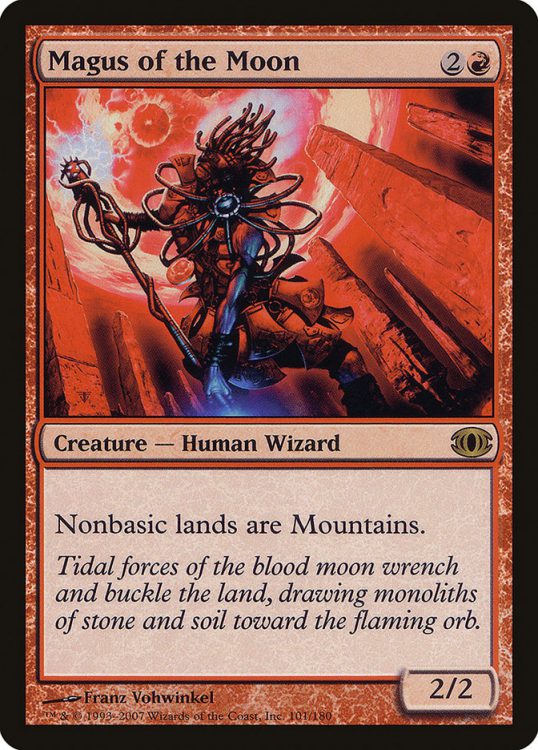
Red
- Boom // Bust – A prison deck using Boom // Bust emerged in Modern in 2020 for mana denial. The Boom side is cheaper than Stone Rain and Molten Rain. A savvy player will choose a land they control that is indestructible or has a triggered ability that triggers when the land is put in the graveyard to mitigate the downside of the cheap land destruction on their opponent. You can even target your own fetchland or a land like Sunbaked Canyon, sacrifice them with Boom on the stack, and still destroy an opponent’s land because the spell has multiple targets. You probably won’t be casting the Bust side of the card very often, but it’s an Armageddon effect when you need it.
- Grapeshot – The centerpiece of the Modern storm deck. Reaching a spell count of twenty (or more likely eighteen or nineteen because of fetchland usage) is a tall order, but storm decks combine the fast mana spells Desperate Ritual, Pyretic Ritual, Manamorphose, and cheap cantrips to reach a storm count of nine or ten, cast Grapeshot, then flash it back with Past in Flames for the second burst of damage. The deck also plays Empty the Warrens as an alternate win condition if Grapeshot can’t be played.
- Greater Gargadon – This 9/7 creature is expensive to cast, has a very long suspend time, and the ability to take off its time counters seems counterintuitive. It can combo with Restore Balance and As Foretold by sacrificing all of your lands and creatures while Greater Gargadon is suspended, casting Restore Balance with As Foretold, and wiping out all of your opponent’s creatures and lands with a bigass creature to follow up with. Don’t forget that Greater Gargadon (and any other creature) cast from exile with suspend has haste, because all editions of Greater Gargadon don’t have reminder text on them.
- Magus of the Moon – This card is usually included in prison decks to serve as copies 5-8 of Blood Moon, but a Blood Moon that can attack and block is useful.
- Simian Spirit Guide – The colorshifted version of Elvish Spirit Guide finally ate a ban in Modern in February and was a long time coming. Any deck running it was up to shenanigans by rushing out a Blood Moon on turn two or turn one if you were lucky, or cast a Chalice of the Void with one charge counter on turn one. It also played a role in ramping out Eldrazi creatures during Eldrazi Winter in 2016 after the release of Oath of the Gatewatch. The timing of the ban makes this reprint awkward, but it remains legal in Legacy and Pauper.
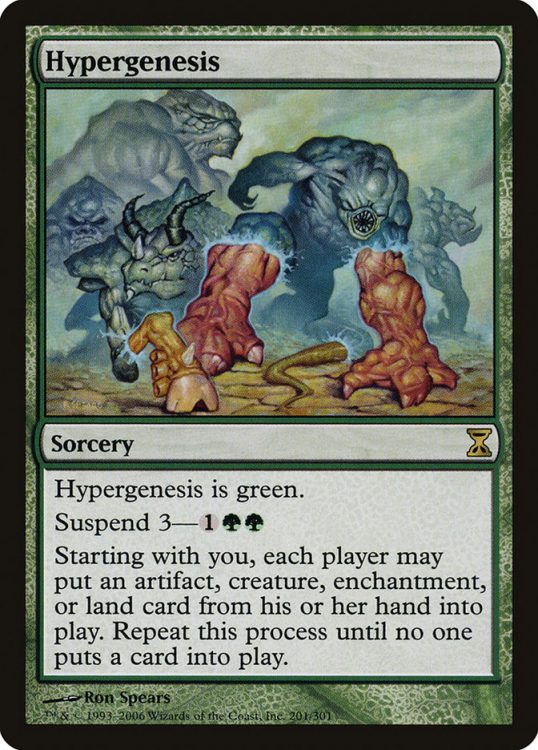
Green
- Hypergenesis – This card is one of the original twenty-one cards banned in Modern since its creation in 2012. Its inclusion is probably to fill in the cycle of cards that can only be cast from suspend and for whoever wants it for Commander. The combo for Hypergenesis is to load your hand with as many uber creatures as you can and then cast Hypergenesis with a card with cascade. In the last Extended season that Hypergenesis was legal in, you would try to get Progenitus onto the battlefield this way by turn three or other creatures that have very high power and toughness and are difficult to remove. Emrakul, the Aeons Torn, Griselbrand, and Xenagos, God of Revels hadn’t been printed yet, but you can only imagine what that deck would look like today if it were legal.
- Summoner’s Pact – The green member of the Pact cycle will tutor for any green creature in your library. The cost for the pact is a little steep, but the decks that run it are ramp decks searching for a Primeval Titan.
- Tarmogoyf – Oh how the mighty have fallen. Tarmogoyf was the undisputed champion of idiot creatures that can do only one thing: attack and block. Its low mana cost of 1G made it fit into any midrange or control deck that could splash for green. Tarmogoyf is a 2/3 or 3/4 creature on turn two. Usually, Tarmogoyf is cast in the midgame on turn four or five when it can close the game and at a massive 5/6 or 6/7 once graveyards have been filled with several card types with mana still up to cast counterspells or remove creatures. Raising its power is simply a matter of playing the game, which is made even easier in formats with fetchlands that can check off the land type on turn one. It’s very difficult to remove from the battlefield in combat, and one of the best counters for it in combat is another Tarmogoyf. Red damage-based removal is almost always insufficient at removing it and black removal spells that lower power and toughness need to be able to cut it down by -4 or -5 to deal with it. Tarmogoyf holds equipment very well because of the difficulty in removing it. It took the printing of Fatal Push in Aether Revolt to finally dethrone Tarmogoyf as the best midrange creature ever printed and the rise of Death’s Shadow decks (though they are often seen together). Fatal Push is always online for a creature like Tarmogoyf because it’s converted mana cost is 2 and doesn’t carry the same massive life loss of Dismember to erase it for only one mana. Path to Exile already achieved this feat for one mana, but a second color getting a point removal spell for only one mana that can answer most creatures was the straw that broke the camel’s back. Despite its fall from power, Tarmogoyf is still an absolute house and remains relevant in Modern and Legacy. If you’ve ever been on the fence about acquiring Tarmogoyfs, now is a good time to spring for them.
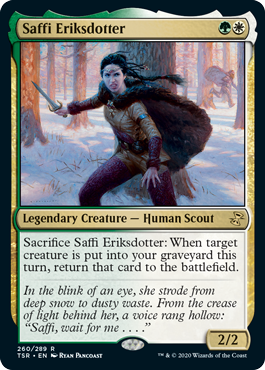
Multicolor
- Glittering Wish – A callback to the wish cycle from Judgment, Glittering Wish is used in toolbox decks that look for cards that win you the game or a silver bullet for your opponent’s win condition. The limitation is that it can only find a multicolor card out of your sideboard. A card with a hybrid mana symbol in its casting cost counts as a multicolor card,
- Saffi Eriksdotter – A card born out of a meme before there was ever such a thing. Saffi Eriksdotter briefly found a home in Collected Company decks where it was paired with Renegade Rallier. The combo can be done infinitely with a third card that has an activated ability with a cost that sacrifices a creature, which gives you an infinite number of triggers for Blood Artist to deal enough life loss to your opponent to win the game.
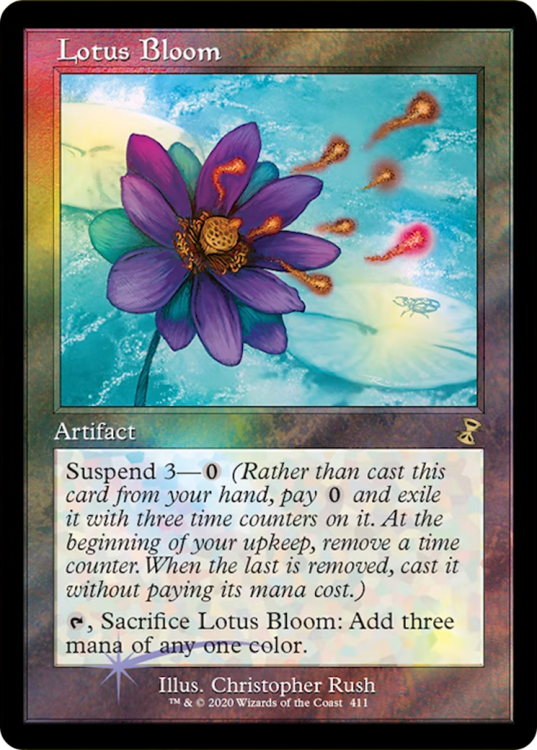
Artifact
- Chromatic Star – This card functions similarly to Chromatic Sphere in providing a filter of one color of mana to another and drawing a card. Both cards can convert colorless mana into mana of any color, providing Urzatron decks access to green mana for ramp spells, artifact destruction, or Thragtusk. Chromatic Star’s cantrip ability triggers whenever it is put into a graveyard from the battlefield, so you can still get something out of it in any deck that needs to sacrifice artifacts to meet a cost or if it gets destroyed.
- Lotus Bloom – No deck in the history of Magic has ever been up to any good with Black Lotus or its descendants. Combo decks will suspend as many copies of Lotus Bloom as they can on their first or second turn in order to ramp to an outrageous amount of mana on their critical turn to cast a spell like Ad Nauseam and cast a Lightning Storm or Thassa’s Oracle to win the game before their Angel’s Grace wears off. Decks that can recur artifacts from their graveyard for up to two mana can get infinite uses out of Lotus Bloom and dump all of that mana into an X spell that wins the game.
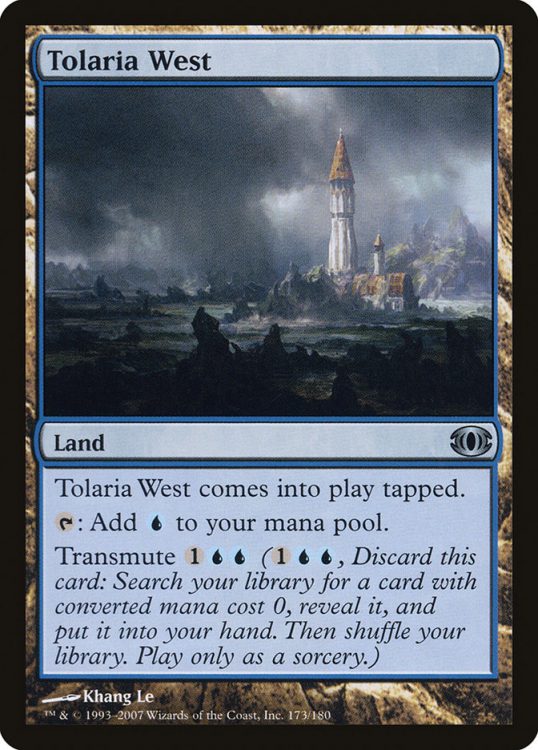
Lands
- Flagstones of Trokair – Flagstones negates the costs of spells and abilities that require you to sacrifice or destroy one of your own lands be replacing itself with a Plains or a typed dual land. This ability can also rump up your landfall triggers.
- Gemstone Caverns – Gemstone Caverns has the distinction of being designed by a Magic Invitational participant that didn’t win the event, but the design was popular enough among the community that it was printed. It’s also a callback to Gemstone Mine. It is also yet another card that is used only to play unfair Magic. The restrictions on getting the luck counter on it are pretty tight, but having a land on the battlefield as a turn zero action that can tap for any color will put you at a great advantage and ramp you toward casting your four or five CMC spells a turn sooner. It’s become weaker without Simian Spirit Guide in Modern, but the effect is still powerful.
- Tolaria West – There aren’t many spells in Modern that have a converted mana cost of zero, but what Tolaria West can find is cards like Walking Ballista, Hangarback Walker, any of the suspend spells with no mana cost, the Pact spells, Chalice of the Void, Mox Amber, Stonecoil Serpent, Mishra’s Bauble, and any land card. It’s usually used in Amulet Titan decks in Modern to find its utility lands, but the ability to dig for a Pact of Negation at instant speed to push through your combo is absurd. Transmute is an activated ability, so it can’t be countered by counterspells that target a spell.
- Urborg, Tomb of Yawgmoth – For decks where heavy black costs are necessary, Urborg will make all of your lands on the battlefield tap for black mana unconditionally. Even in monoblack decks, Urborg will turn all of your utility lands and colorless lands into swamps and allow you to meet your black mana costs without any problems.
- Vesuva – It’s a copy of any land you want it to be. It’s only useful in decks that require multiple copies of a land on the battlefield, but having a fifth or sixth copy of that crucial land improves consistency. In Modern, it can turn into a Ravninca bounceland to ramp your mana or become another copy of Valakut, the Molten Pinnacle. You can even use one of those bouncelands to return Vesuva to your hand so you can play it again later as a Valakut.
Have any questions or feedback? Drop us a note in the comments below or email us at contact@goonhammer.com.
